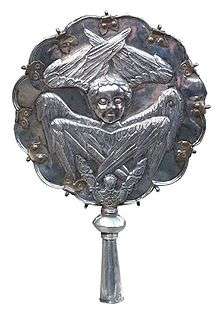Liturgical fan in Eastern Christianity
The hexapterygon, ripidion, or seraphic fan is a ceremonial fan used in Eastern Christian worship (including in the Orthodox Church, the Non-Chalcedonian or Oriental Orthodox Churches, the Assyrian Church, and the Eastern Catholic Churches under the See of Rome).[1][2] Ripidia are carried by the altar servers at all processions with Eucharistic gifts and the Gospel Book.[3]

In the Eastern Churches, the sacred ἑξαπτέρυγον, hexapterygon, plural: ἑξαπτέρυγα hexapteryga—literally, "six-winged"), have been used from the first centuries to the present day. It is generally made of metal, round, having the iconographic likeness of an angel with six wings, and is set on the end of a pole. Hexapteryga of carved, gilded, or painted wood are also found. They are usually made in pairs. For historical use in Western Christianity, especially the Latin Church, see flabellum.

In the Byzantine Rite, the hexapteryga are carried during the Great Entrance and at all processions; in the Russian Orthodox tradition they are often also used to honour a particularly sacred icon or relic. When not in use, the hexapteryga are usually kept in stands behind the Holy Table in the Greek Orthodox and Melkite Greek Catholic traditions; in the Slavic traditions they may be kept either there or out of sight elsewhere in the altar. The latter is especially true in northern Russia, where icons of Christ and the Theotokos are usually placed behind the Holy Table.
Hexapteryga used in the Maronite and Oriental (e.g., Coptic, Armenian, Ethiopian) traditions are distinctive, having little hoops of metal or bells all around the circumference of the disks, symbolizing the hymns of the angels to God. At particularly solemn points of the liturgy, these are shaken gently to produce a tinkling and jingling sound, akin to the sound of multiple altar bells.
Further reading
Enhanced Strong’s Lexicon, James Strong, Oak Harbor, WA, Logos Research Systems, 1995. (Αρ. λέξης 03742). The Anchor Bible Dictionary, Freedman, David Noel, New York, Doubleday, 1997/1992. Pseudo-Dionysius Areopagita, De coelesti hierarchia, [Patristische Texte und Studien 36. Berlin: De Gruyter, 1991]
Εγκυκλοπαίδεια, «Πάπυρος, Larousse, Britannica», Εκδόσεις Πάπυρος, Αθήνα, 1976/2006 Catholic Encyclopedia Ο κόσμος των αγγέλων Αρχιμανδρίτου Ιωάννου Καραμούζη